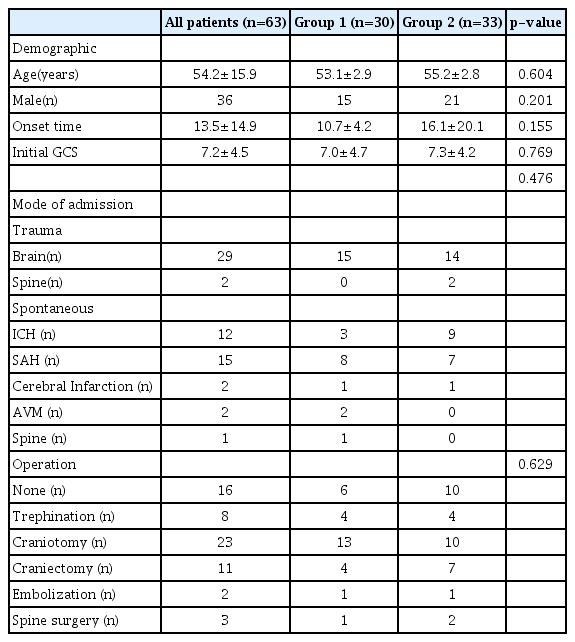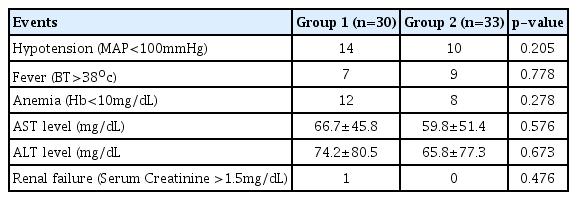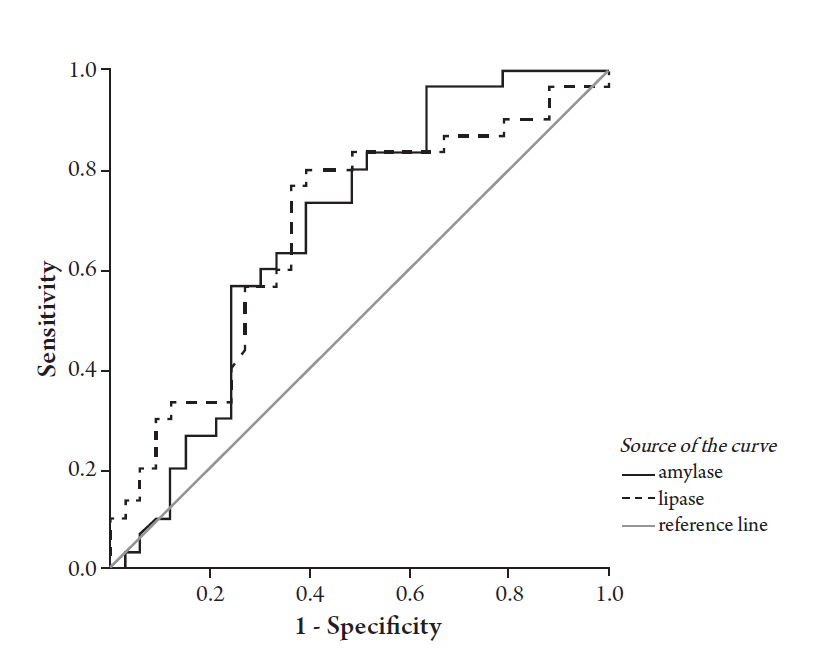Analysis of Elevated Serum Amylases, Lipase Levels in Neurointensive Care Unit Based on Abdominal CT Scan
Article information
Abstract
Objective
To evaluate the clinical characteristics of patients in neurointensive care unit (NICU) whose pancreatic enzyme has elevated and the appropriate cut off value of amylase, lipase for conducting the computerized tomography (CT) scans.
Methods
This was retrospective study of 66 patients in NICU unit who had elevated pancreatic enzymes from January 2008 to December 2013. We classified the subjects with two groups according to CT findings of pancreas – Balthazar score. Patients’ demographic and clinical data was analyzed and level of amylase, lipase was evaluated using receiver operating characteristics curve.
Results
The patients were categorized into 2 groups according to CT findings. Morphologic alteration of pancreas was classified in Group 1, and normal pancreas in CT findings was classified in Group 2. There were no statistical differences between groups, but peak serum lipase level was elevated in Group 1 with statistical significance (p=0.032). By receiver operating characteristics (ROC) curve, we could suspect pancreatitis more precisely in patients with elevated amylase levels > 2-fold the upper normal limit (207 U/L, 73.3% sensitivity and 60.6% specificity), or elevated lipase levels > 4-fold the upper normal limit (1243 U/L, 80% sensitivity and 60.6% specificity) calculated by maximum of the Youden index.
Conclusions
According to our results, serum lipase level is more significant value for pancreatitis. And abdominal CT should be considered if patient’s amylase levels are more than 2-fold and lipase levels are more than 4-fold.
INTRODUCTION
Acute pancreatitis is a gastrointestinal disease with hyperamylase, hyperlipase and accompanied by symptoms such as epigastric abdominal pain, nausea, vomiting1). In intensive care unit, patients with elevation of pancreatic enzymes is common, and for further evaluation, an imaging study such as abdominal sonography or computerized tomography (CT) is performed2). However, it is difficult to know whether the elevation of amylase, lipase means the acute pancreatitis because neurointensive care unit (NICU) patients cannot express abdominal symptoms due to decreased level of consciousness. Patients in NICU are already exposed to radiation due to frequent brain CT scans, and the patient's transfer for study is often limited. Although abdominal imaging study is essential for diagnosis in acute pancreatitis, not all patients in NICU with hyperamylase, hyperlipase can be scanned with abdominal study3). For this reason, the diagnosis of acute pancreatitis in NICU is limited, and it is very important to suspect and diagnose the acute pancreatitis because the severe acute pancreatitis causes sepsis and affects the patient's outcome. The objective of this study is to evaluate the clinical characteristics of patients in NICU whose pancreatic enzyme has elevated. Also, we evaluate the appropriate cut off value of amylase, lipase for conducting the CT scans.
MATERIALS AND METHODS
Our study was approved by the institutional review board (IRB number 2020-09-008). From January 2008 to December 2013, 1789 patients were admitted to our NICU. We initially excluded patients who had elevated pancreatic enzymes (amylase or lipase) at the time of hospitalization. Reference range of amylase was 30-110 U/L, and reference range of lipase was 23-300 U/L. 134 patients had elevated pancreatic enzymes in clinical course, and we finally enrolled 63 patients who had assessed the pancreas by contrast-enhanced abdominal computed tomography. We classified the subjects with two groups according to CT findings: Group 1 - morphological alteration of pancreas, Group 2 – normal pancreas. The CT findings was based on Balthazar score4). The morphologic alteration of pancreas means Balthazar grade B, C, D, E and normal pancreas means Balthazar grade A. The data associated with the patients’ demographic characteristics and the clinical information was obtained from their medical records and analyzed retrospectively. The data included age, gender, indication of admission to NICU, types of surgery, initial Glasgow coma scale (GCS) score, mode of admission. We obtained data of clinical information; vital sign (body temperature, mean arterial pressure), serum markers (hemoglobin, creatinine, alanine aminotransferase, aspartate aminotransferase).
Data were analyzed using version 23 of the Statistical Package for the Social Sciences (SPSS) software (SPSS Inc.). Fisher’s exact test was used to categorical variables and for continuous variables independent t-test or Mann-Whitney U-test were used. We analyzed amylase and lipase using receiver operating characteristics (ROC) curve maximum of the Youden index.
RESULTS
(A) The patients were categorized into 2 groups; there were 30 patients (47%) in Group 1 and 33 patients (53%) in Group 2. In comparison of demographic and clinical characteristic data, there were no statistical differences between groups (Table 1). Mean age was 54.2 (Group 1: 53.1, Group 2: 55.2), there was no significant difference (p=0.604). Thirty-one patients were hospitalized for trauma and 32 patients with spontaneous diseases. Sixteen patients received conservative treatment without surgery and 47 patients underwent surgery. 8 patients were treated with trephination, 23 patients with craniotomy, 11 patients with craniectomy, 2 patients with coil embolization due to aneurysmal rupture, 3 patients with spine surgery. There were no statistical differences. And there were no differences in clinical events: Hypotension (Mean arterial pressure<100mmHg), Fever (Body temperature >38°c), Anemia (Hemoglobin <10mg/dL), Asparatate aminotransferase (AST), Alanine aminotransferase (ALT) level (mg/dL), Renal failure (Serum Cr>1.5mg/dL (Table 2). In mortality, 3 patients in Group 1 and 2 patients in Group 2 were expired by primary neurosurgical diseases not pancreatitis (Table 3).

Demographics and clinical factor of patients in neurointensive care unit who had elevated pancreatic enzymes

Clinical outcomes of patients with elevated pancreatic enzymes. There was no statistical difference between two groups. And there was no death related with pancreatitis.
(B) GCS was classified with score; 13~15 was mild, 9~12 was moderate, 3~8 was severe (Table 4). Mean serum amylase was 213 U/L in patients with mild GCS, 229 U/L in patients with moderate GCS, 328 U/L in patients with severe GCS. Mean serum lipase was 1695 U/L in patients with mild GCS, 1850 U/L in patients with moderate GCS, 1906 U/L in patients with severe GCS. There were no statistical differences (p=0.327 in amylase, p=0.657 in lipase).
(C) Peak serum lipase level was elevated in Group 1 with statistical significance (p=0.032). Peak serum lipase level was 2459.4 U/L in group 1, and 1533.2 U/L in Group 2 (Table 5, Fig. 1). But there was no statistically difference in amylase levels between the two groups (p=0.082). By ROC curve, we could suspect pancreatitis more precisely in patients with elevated amylase levels > 2-fold the upper normal limit (207U/L, 73.3% sensitivity and 60.6% specificity), or elevated lipase levels > 4-fold the upper normal limit (1243 U/L, 80% sensitivity and 60.6% specificity) calculated by maximum of the Youden index (Fig. 2).

Difference of serum amylase, lipase level between two groups. There was a statistically significant difference in the level of the lipase

Comparison of peak serum level of amylase, lipase in two groups and box plot. Peak lipase level was significantly elevated in Group 1. CT positive: Group 1, CT negative: Group 2
DISCUSSION
There are some studies about asymptomatic elevated serum amylase and lipase level in the intensive care unit (ICU). Particularly, the reported incidence of these without pre-existing pancreatic lesions are varies from 15% to 66% in NICU2,5,6). Liu et al reported that 11 (15%) of the 75 patients with intracranial events had experienced increased serum amylase and lipase levels and Justice et al noted that 25 (66%) of the 38 patients diagnosed with intracranial hemorrhage had hyper-lipasemia, and 17 (45%) of these 25 patients had also hyper-amylasemia5,6). Vitale et al described that there was a 38% prevalence of hyper-amylasemia in patients with traumatic brain injury7). Manjuck et al examined the incidence associated with asymptomatic elevated serum lipase level in the ICU and 40% of patients were identified2). In our study, 134 (7%) of the 1789 patients were observed with elevated pancreatic enzymes which is a proportion less than often reported results and among them, 63 patients were performed contrast enhanced abdomen CT. Though retrospective study, elevated serum pancreatic enzymes were slightly lower encountered in our NICU, but not uncommon clinical events.
Prior studies have revealed several possible factors which are associated with elevated serum pancreatic enzymes in critical ill patients, such as age, GCS score, fever, hypotension, anemia, renal failure, serum AST and ALT levels2,5,6,8). Hypotension was observed in 24 patients (38 patients), fever in 16 patients (25%), anemia in 20 patients (31%), renal failure in 1 patients (1%). 38 patients (60%) was noted elevated serum AST level and elevated serum ALT level was observed in 34 patients (54%). Mean serum AST level was 66.7mg/dL in Group 1, and 59.8mg/dL in Group 2. And mean serum ALT level was 74.2mg/dL in Group 1, and 65.8mg/dL in Group 2. In our study, there was no statistical difference in clinical events during ICU admission.
Common mechanisms of elevated pancreatic enzyme are over production by inflammation, pathologic tissue or drug and reduced clearance of serum amylase or lipase in the body2,5,8,9). Vitale et al studied 60 patients with severe head injury and reported that severe head injury activated the pathways that increase amylase levels in the blood. They explained that the central nervous system may regulate the serum amylase levels7). In this study, though we did not examine all possible factors leading to increase serum pancreatic enzymes, these patients without pre-existing pancreatic lesion might be influenced by vagal stimulation from altered modulation of central control of pancreatic enzyme release after brain accidents.
The pancreas and the salivary glands play an important role in the serum amylase level, and therefore the diagnosis of acute pancreatitis may be usually rest on an amylase level10). Besides elevated serum lipase may appear in the absence of clinical or radiological evidence of acute pancreatitis5,6). Pacheo et al assessed validity of serum amylase and lipase for the diagnosis of acute/chronic pancreatitis prospectively and concluded that the sensitivities of both enzyme were similar, but the specificity and positive predictive value of serum amylase (92.6%/83.2%) were higher than serum lipase (88.8%/75.8%)11). Denz et al studied prospectively accuracy of pancreatitis-associated protein (PAP) comparing serum lipase level to diagnose acute pancreatitis in critical ill patients and they confirmed acute pancreatitis using contrast-enhanced computed tomography. They concluded that serum PAP values were significantly higher in patients with morphological alterations of the pancreas12). We obtained serum lipase level from patients when serum amylase level was peaked because of higher sensitivity and specificity of serum amylase for diagnosing of pancreatitis. Mean value of serum lipase level was more elevated in Group I (p=0.032) and peaked serum amylase level was indistinguishable (p=0.082). Manjuck and Lee reported peak serum lipase value in patients with increased pancreatic enzymes who had a normal appearance of pancreas in radiologic study was lower level than those who had an abnormal appearance of pancreas with statistical significance (p<0.01)2,8). Gwozdz et al compared the diagnostic sensitivities of serum amylase, lipase, trypsinogen, and elastase and concluded that on hospital admission, all four serum assays were equally sensitive, but on subsequent days lipase, trypsinogen and elastase significantly surpassed the sensitivity of the serum amylase assay13).
In previous study, Manjuck et al studied the optimal cut-off value and assessed the average amylases level in a confirmed diagnosis was approximately three times the upper normal limit, and the average lipase level was approximately five times2). Lee et al evaluated nearly half of the patients admitted to the NICU with gastrointestinal signs had elevated serum pancreatic enzyme levels and suggested abdominal CT should be indicated for patients if serum amylase levels are more than three-fold and lipase levels are more than five-fold the upper normal limits8). In this study, the optimal cut-off values for amylase were two times (207 U/L) the upper limit of the normal reference (sensitivity 73%, specificity 61%) and lipase were four times (1244 U/L) the upper limit of the normal reference (sensitivity 80%, specificity 61%) calculated by maximum of the Youden index. These cut-off values were a little lower value than previous study. We assumed that this gap of cut off values was because numbers of enrolled patients with pancreatitis confirmed by abdominal CT or ultrasound were different; 11 patients for Manjuck et al, 9 patients for Lee et al, and 30 patients for this study.
Lee et al reported the causes of mortality for 14 patients with elevated pancreatic enzymes were brain insult or sepsis without intra-abdominal events8). Mortality of our two groups confirmed by abdomen CT scan were similar (p=0.662) and the causes of death were related with primary their diagnoses not pancreatic problem; 2 patients for traumatic brain injury, 1 patients for cerebral infarction, and 2 patients for aneurysmal subarachnoid hemorrhage.
Our study has several limitations. Our study was a retrospective study and not a randomized controlled study. And sample size was relatively small. Further randomized, controlled studies with a larger study population are required.
CONCLUSION
The results of the present study have revealed that we should focus on serum lipase level during follow-up in patients with elevated pancreatic enzyme and GCS scores do not affect serum amylase, lipase level. And, also abdominal CT scan should be considered if patient’s amylase levels are more than 2-fold and lipase levels are more than 4-fold the upper normal limits because we can assume morphologic alteration of pancreas and for these cases.
Notes
Conflict of interest
No potential conflict of interest relevant to this article was reported.


